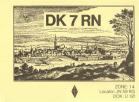 |
 |
 |
 | Amateur Radio |
|
|
Amateur Radio
|
Amateur Radio telecommunication is a very various and broad diversified hobby.
Radio amateurs work within the amateur radiocommunication service on different frequencies and in different operating modes.
Aims of the amateur radiocommunication service are:
Making communication of radio amateurs possible,
making experimental and technical scientific studies,
operating a further education of one's own,
communication between different nations
and supporting relief actions in catastrophe cases
Amateur Radio telecommunication is a hobby that more than 2 million people are worldwide operating.
This hobby knows no political, ethnic and social limits.
All Radio Amateurs have the enthusiasm for technology and wireless communication.
|
Radio Amateurs
|
Radio amateurs deal with the amateur radiocommunication service out of a personal inclination and not from commercial economic interest.
A Radio amateur is allowed to build his radio equipments and the antenna system himself or change also bought transmitters.
This is permitted only to the amateur radiocommunication service.
Radio amateurs must have knowledge in technology, laws and the correct way to do a QSO.
A radio amateur has shown this knowledge in an examination at his national telecommunication administration.
The knowledge which is tested is worldwide identical.
As a certificate for the succesfull check a radio amateur got a license to work on the bands.
|
Amateur radio testimonial classes
|
There are currently two amateur radio testimonial classes in Germany:
Amateur radio testimonial of the class E (Novice license)
Amateur radio testimonial of the class A (Advanced license)
In both classes you have to do a very hard examination.
A radio amateur with the A-license has more privileges than the one with the E-license.
|
Call signs
|
A call sign with which the participation in the amateur radiocommunication service gets possible for him can be assigned to the radio amateur after been examinated.
The call sign of a radio amateur generally consists of a one or two-digit prefix (prefix), followed by a number and a one to three-digit suffix (letters together).
My call sign is DL1STV.
The letters of the prefixes of Germany are DA...DR.
The USA became the letters K, N and W.
|
Modes
|
In the amateur radiocommunication service different modes are possible/usual.
These corresponds to the experimental character of the amateur telecommunication.
I mention here:
|
|
|
 |
CW (continous wave, sending a message in Morse code telegraphy)
|
 |
Telephony (language transmission) in FM (frequency modulation) or SSB (Single Side Band modulation)
|
 |
Earth moon earth connections
|
 |
Operation to/over amateur telecommunication satellites
|
 |
ATV amateur telecommunication television
|
 |
SSTV (Slow Scan television)
|
 |
Facsimile via HF
|
 |
HF teletypewriting
|
 |
PSK31
|
 |
Amtor
|
 |
Pactor
|
 |
Packet Radio
|
 |
Echo link
|
 |
and much more
|
|
Contacts are also possible by earth moon earth connections or Meteorscatter connections.
FM-Repeaters and echo link, satellites (e.g. amateur telecommunication satellites) complete the possibilities of radio communication.
Radio amateurs have built satellites of their own which permanently orbit the earth and which one can use as a relay station (Oscar).
Also short time existing natural appearances, such as Aurora (reflection of the radio waves at polar lights) or the reflection of radio waves at aeroplanes or the international space station are used to the overcoming of larger distances.
|
Radio amateur awards
|
Sometimes it's possible to get a Radio Amateur Award:
e.g. for radio contacts to all countries of the earth
or a number of certain connections during a particular time period on occasion of a certain event (e.g. anniversary 1000 years city of Fürth)
Examples:
|
|
|
|
QSL-cards
|
Even today, particularly important radio conversations (QSOs) are confirmed with QSL cards.
With a QSL card a radio amateur confirms to another radio amateur that a QSO has taken place between both.
The QSL cards are either sent out directly by post or sent as a special service of the DARC over the DARC-QSL office.
QSL cards are particularly popular of rare amateur telecommunication stations to be worked hard or of stations with particularly beautiful QSL card motives.
Here some examples:
|
|
OM Stephan / Beratzhausen |
OM Teruaki / Osaka, Japan |
OM Herbert / Neumarkt |
OM Peter / Neumarkt |

|

|

|

|
|
OM Thomas / Schwabach |
OM Hassan / Morocco |
OM Jim / Taneytown, MD, USA |
OM Norman / Cyprus |

|

|

|

|
|
YL Elvira / Djibouti / Africa |
OM Erkki / Finland |
OM Ted / Dominican Republic |
OM Ron / Toronto / Canada |

|

|

|

|
|
OM Sergey (Rebrov) / Moldavia |
OM Dov / Israel |
OM Bob / Thailand |
OM Andy / Romania |

|

|

|

|
|
OM Walter / Madeira |
Hamdxgroup Team / Lighthouse Cabo la Nao in Spanien |
YL Marita / Bremerhaven |
OM Otto / Faroe Islands |

|

|

|

|
|
|
More QSL-cards
|


